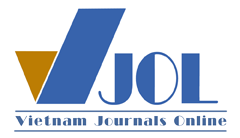Removal behavior of Pb2+, Cd2+, Zn2+ from wastewater of lead, zinc mining – Cho Don, Bac Kan by halloysite clay
DOI:
https://doi.org/10.51316/jca.2023.036Keywords:
halloysite, adsorption, removal of Pb2+, Cd2+ ions, Zn2+ionsAbstract
Halloysite from Thach Khoan, Phu Tho province showed nanotube structure with a chemical formula Al2Si2O5(OH)4.2H2O when fully hydrated and Al2Si2O5(OH)4 when dehydrated, specific surface areas are 15.7434 and 22.0211 m2/g. Halloysite was used to study on adsorption behaviour of Pb2+, Cd2+, Zn2+ (M2+) ions. The effect of factors on the M2+ adsorption efficiency was investigated. The adsorption efficiency of Pb2+, Cd2+, Zn2+ obtained 90.75; 73.75 and 67.09 % respectively under the suitable condition: halloysite mass of 0.7 g/50 mL solution, initial concentration of 40 mg/L M2+, pH for Pb2+, Cd2+, Zn2+ = 5.31; 6.2; 5.6 espectively, contact time of 80 minutes (for Pb2+, Cd2+) and 100 minutes (for Zn2+) at room temperature (30 oC). Adsorption isotherm curves were studied based on Langmuir and Freundlich models. The kinetic of the adsorption process was investigated following the first-order-pseudo and second-order-pseudo models. Removal efficiency of Pb2+, Cd2+ and Zn2+ from the wastewater of lead, zinc mining – Cho Don, Bac Kan was 99,59 %; 92,08 % và 99,46 %, respectively.
Downloads
References
Phạm Luận, Vai trò của muối khoáng và nguyên tố vi lượng đối với sự sống của con người, Trường Đại học Khoa học Tự nhiên, Đại học Quốc gia Hà Nội, 1998.
Fu F., Wang Q., J. Environ. Manage. 92(3) (2011) 407–418. https://doi.org/10.1016/j.jenvman.2010.11.011
Bùi Hoàng Bắc, Nguyễn Tiến Dũng, Lê Thị Duyên, Võ Thị Hạnh, Hội nghị toàn quốc Khoa học trái đất và tài nguyên với phát triển bền vững (ERSD), Hà Nội 12/2018. https://doi.org/10.1016/j.molliq.2020.113077c.
Doãn Đình Hùng, Nguyễn Trung Minh, Nguyễn Thị Thu, Cù Sỹ Thắng, Lê Thị Phương Dung, Tạp chí Địa chất, loạt A, số 340 (2014) 79 - 90.
Ioannis Anastopoulos, Alok Mittal, Muhammad Usman, Jyoti Mittal, Guanghui Yu, Avelino Núñez-Delgado, Michael Kornaros, Journal of Molecular Liquids 269 (2018) 855–868.
https://doi.org/10.1016/j.molliq.2018.08.104
Nguyễn Thị Hải, Đặng Ngọc Thăng, Nguyễn Thị Hoàng Hà, Tạp chí Khoa học ĐHQGHN: Các Khoa học Trái đất và Môi trường, Tập 32, Số 2S (2016) 198-205.
Nazarii Danyliuk, Jolanta Tomaszewska, Tetiana Tatarchuk, Journal of Molecular Liquids 309 (2020) 113077. https://doi.org/10.1016/j.molliq.2020.113077
Nguyễn Trung Minh, Nguyễn Đức Chuy, Cù Sỹ Thắng, Nguyễn Thị Thu, Nguyễn Kim Thường, Nguyễn Trung Kiên, Trần Thị Thu Phương, Nguyễn Kim Thùy, Nguyễn Văn Thành, Huỳnh Minh Trí, Seong-Taek Yun, Tạp chí Địa chất, loạt A, Số 320 (2010) 227 - 235
Lê Thị Duyên, Võ Thị Hạnh, Công Tiến Dũng, Đinh Thị Mai Thanh, Vietnam Journal of catalysis and Adsorption, Vol.10(2) (2021) 36-42. https://doi.org/10.51316/jca.2021.025
Nguyễn Thị Đông, Nguyễn Tiến An, Đỗ Trường Thiện, Đào Văn Bảy, Tạp chí Hóa học, Tập 50, Số 4B (2012) 95 - 98.
Lê Thị Duyên, Lê Thị Phương Thảo, Phạm Tiến Dũng, Phạm Thị Năm, Nguyễn Thị Thơm, Cao Thị Hồng, Đinh Thị Mai Thanh, Tạp chí Hóa học, T55(3E12) (2017) 167-171.
Neha G., Atul K., Chattopadhyaya M.C., Journal of the Taiwan Institute of Chemical Engineers 43(1) (2012) 125-131. https://doi.org/10.1016/j.jtice.2011.07.009
Muniyappan R.G., Kousalya G.N., Meenakshi S., International Journal of Biological Macromolecules 48 (2011) 119-124. https://doi.org/10.1016/j.ijbiomac.2010.10.009
Đỗ Trà Hương, Đặng Văn Thành, Mai Quang Khuê, Nguyễn Thị Kim Ngân, Tạp chí Hóa học, Tập 54, Số 1 (2016) 64 - 69.
R.R. Sheha, Journal of Colloid and Interface Science, Vol. 310(1) (2007) 18-26.











